Situated on the outskirts of The Bush village near Dungannon, Co Tyrone, David McMullan runs a dairy enterprise milking 40 cows alongside operating a small contracting business.
As far back as David remembers, silage on the family farm was always cut by the family themselves.
“My uncle and my father were partners in a silage outfit up through the years. It worked, as everybody brought something to the table,” he said.
David’s uncle then decided to go down the contractor route. However, wanting to remain lifting his own grass, David bought a secondhand forage wagon.
A wagon suited as less labour was required. He bought a used Claas Sprint 445s wagon which was later upgraded for a Claas Quantum 3800p 11 years ago.
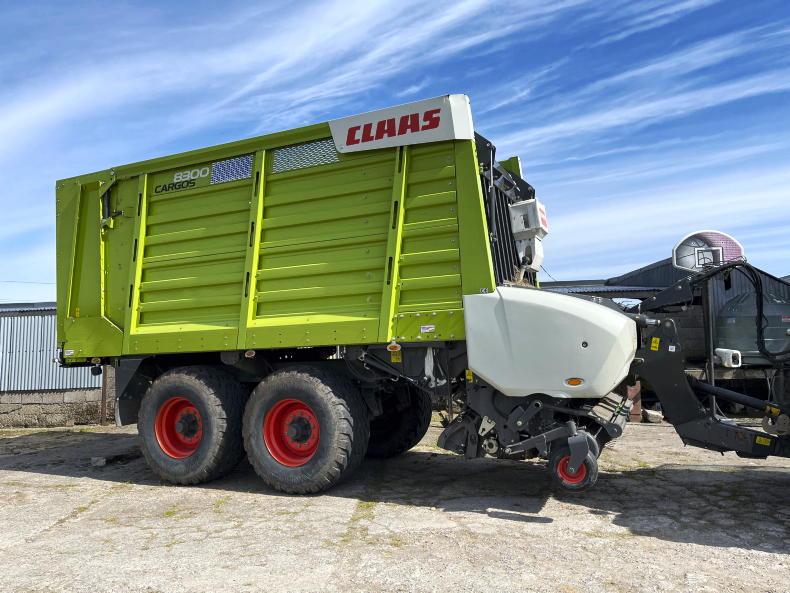
The Cargos 8300 is the smallest of the three models in the range.
To this day, David still enjoys doing his own silage. The major benefit, he says, is the fact he is at his own mercy as to when grass is cut and lifted.
During ownership of the Quantum machine, David started picking up work from local farmers to do their silage, growing to the point of cutting and lifting circa 200 acres annually.
David made the decision to upgrade his forage wagon for the Cargos 8300. He noted that the small bit of contracting suits and helps make owning a fresh machine feasible.
The Cargos 8000 series was first introduced in 2015, comprising of three models - the 8300, 8400 and 8500, with capacity ranging from 30m3 to 41m3.
“I bought the 8300 as an ex-demonstrator at the end of the season. Straight away, having demonstrated it earlier that season, I was impressed.
“It was well ahead of my machine at the time in terms of features and performance.”
Pickup and rotor
The three-model Cargos 8000 range is fitted with a 2m hydraulically driven pickup reel. It has a five tine rows with tine spacing of 61mm.
The benefits of the hydraulic drive pickup are zero maintenance and the absence of chains and sprockets, which tend to wear.
The downside is that in heavy crops, the pickup can occasionally slow and stop, giving the impression that the motor doesn’t have quite the amount of torque as that of a stand chain-drive pickup.
One other point David made was that the central guide roller underneath the pickup can occasionally catch in soft ground conditions and drag.
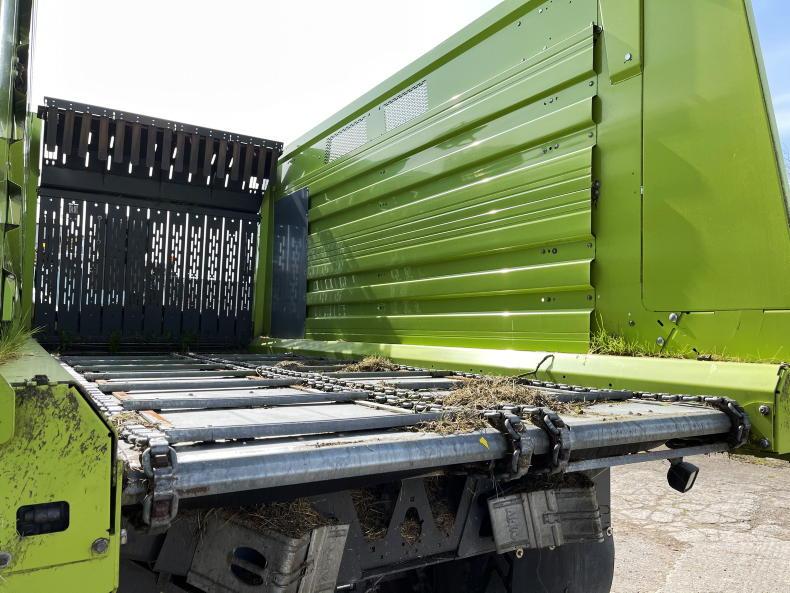
The wagon is fitted with a galvanised floor.
Replacement of its bearings have been the only repair made to the machine since delivery, he explained. Aside from this, the pickup follows the ground well and is well able to gather grass.
Positioned low and close to the pickup is the 1.58m-wide, 860mm-diameter rotor. The rotor has nine tine rows arranged helically.
David noted that transfer of grass to the rotor from the pickup, regardless of length and whether wet or dry, cannot be faulted.
However, he did note that in wet conditions, depending on floor speed and grass compression, grass can be regurgitated from the rotor and fall back down into the pickup.
Uniquely, the rotor is constructed from individual tine segments which are bolted together. In the event of damage, individual segments can be replaced.
The chopper unit is fitted with 40 double-sided knives, capable of producing a theoretical chop length as short as 38mm.
David’s machine is fitted with the optional hydraulically lowering chopper housing, leaving maintenance very straightforward.
A spanner-like locking tool mounted to the side of the wagon unlocks knives for removal. David runs a full set of knives in his 8300 and is impressed with the chop length and consistency.
Another unique feature of the Cargos is that when the chopper unit is overloaded, for example having lifted a foreign object such as a stone, the knives retract individually and the entire knife bank lowers.
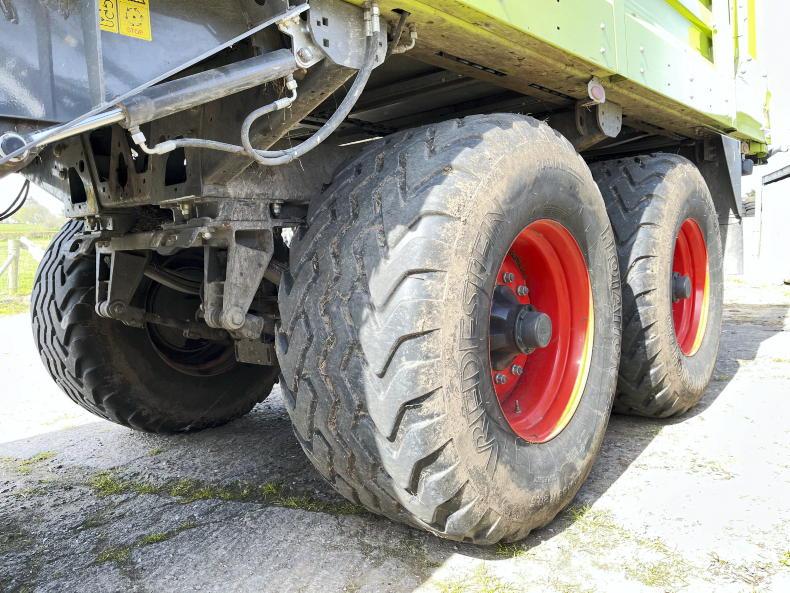
David if buying again would opt for the smaller 22.5in rims to reduce its overall height.
Features and functions
The Cargos 8300 has some interesting features and functions, the first being the pivoting floor.
The first 500mm of the wagon’s floor can pivot hydraulically. This serves for multiple purposes, the first being that it is tilted down during loading, creating an incline from the rotor for better crop flow into the body, as well as helping to compact the crop.
Similarly, during unloading, the pivoting front floor section can pivot upwards to help with the flow of material from the wagon.
Finally, for maintenance purposes, the 500mm floor section can be pivoted 90° downwards to provide standing access behind the rotor and chopper unit. These functions can be carried out manually from the side of the machine if required.
This is a particular feature David likes with the machine. In addition, the drawbar, like many competitor machines, can be raised and lowered hydraulically.
Adding to the flexibility of the Cargos 8300, David explained how the whole pickup and rotor unit can be removed in as little as 20 minutes and placed on to the trolley that came supplied.
This leaves the forage wagon that it can be used as a trailer with an increased 2,500kg payload, while the pickup is kept safe and out of the way.
Control, build and usability
Unlike David’s previous Quantum machine, the Cargos 8300 has full automatic loading and unloading functions, making the process much easier. All functions can be controlled either manually or automatically through the terminal via load-sensing hydraulics.
David commented on how easy the terminal is to use, once having lifted a couple of loads and learned the basics.
The automatic loading system uses a torque sensor positioned on the rotor and a pressure sensor located inside the cylinders which control the position of the headboard.
Both sensors can be set and adjusted from the cab, depending on the degree of compression required. David mainly works off the headboard sensor, meaning it is set to typically move the floor chains before the rotor sensor is triggered.
Although quite a tall machine capable of clipping the odd branch here and there, he finds its short length together with the rear steering axle leaves it very manoeuvrable.
“It is a shorter wagon than the Quantum was, but it carries noticeably more grass, given the shorter chop length and the way it packs the load.
“If I was buying it again new, I would opt for the 710/40 R22.5 tyres instead of the taller 620/55 R26.5 tyres which are on it, this way it would help reduce its height. That said, it pulls well and is comfortable on the road.”
David’s 8300 is fitted with parabolic springs, which are offered as standard, although hydraulic suspension is optional.
“It is a well-built machine with a good strong chassis. The floor is galvanised too instead of timber, so it will last. It’s well designed with things like the floor motor built into the chassis and out of harm’s way.”
Verdict
Having lifted roughly 1,200 acres, David finds it a very easy machine to use and work with.
“It’s a major advancement from our old machine in several ways. Up to now it’s been maintenance-free apart from the support roller bearings in the pickup, which wasn’t a major issue.
“The majority of our meadows are 2.8 to 3 miles away, so it takes roughly 16 hours to lift the 30 acres, with the second- and third-cut taking slightly less,” said David.
“I run it on my Claas Arion 640 which is boosting from 145hp to 175hp.
“It’s well capable for the most part. When the load nears full is the only time you’d like an extra 20hp or so.
“Not doing huge acres, it’s a machine I intend holding on to for a number of years. When the time comes, I couldn’t see myself moving away from Claas wagons based on my experiences with them, that and the fact my dealer is only 10 minutes up the road.”
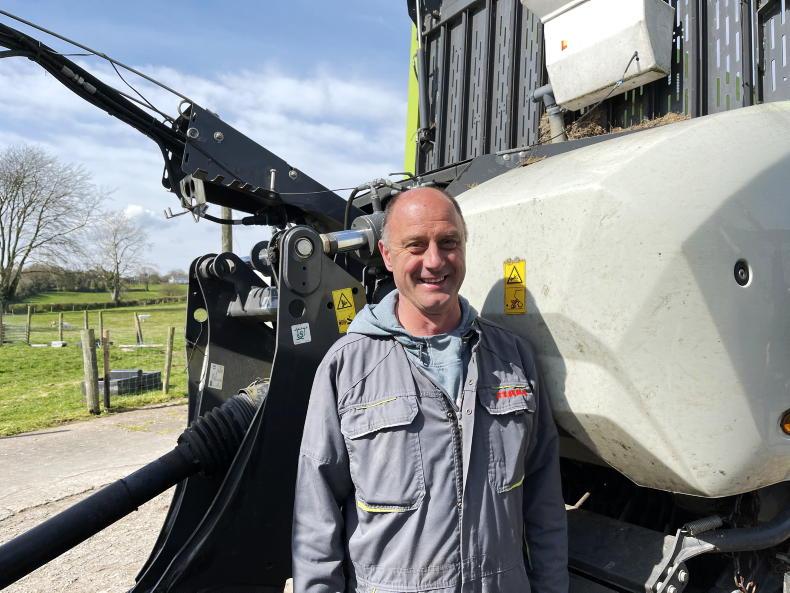
David McMullan, Dungannon Co Tyrone.
? Likes
Build quality.Manoeuvrability.Pivoting floor.? Dislikes
Height.Pickup support roller design.Spec
Model: Cargos 8300.Cubic capacity: 30m3.Pickup: 2m five tine bar, hydraulically driven.Knives: 40 double-sided.Tyres: 620/65 R26.5.Unladen weight: 8,500kg.Base price: €107,530 (£96,380) plus VAT.
Situated on the outskirts of The Bush village near Dungannon, Co Tyrone, David McMullan runs a dairy enterprise milking 40 cows alongside operating a small contracting business.
As far back as David remembers, silage on the family farm was always cut by the family themselves.
“My uncle and my father were partners in a silage outfit up through the years. It worked, as everybody brought something to the table,” he said.
David’s uncle then decided to go down the contractor route. However, wanting to remain lifting his own grass, David bought a secondhand forage wagon.
A wagon suited as less labour was required. He bought a used Claas Sprint 445s wagon which was later upgraded for a Claas Quantum 3800p 11 years ago.

The Cargos 8300 is the smallest of the three models in the range.
To this day, David still enjoys doing his own silage. The major benefit, he says, is the fact he is at his own mercy as to when grass is cut and lifted.
During ownership of the Quantum machine, David started picking up work from local farmers to do their silage, growing to the point of cutting and lifting circa 200 acres annually.
David made the decision to upgrade his forage wagon for the Cargos 8300. He noted that the small bit of contracting suits and helps make owning a fresh machine feasible.
The Cargos 8000 series was first introduced in 2015, comprising of three models - the 8300, 8400 and 8500, with capacity ranging from 30m3 to 41m3.
“I bought the 8300 as an ex-demonstrator at the end of the season. Straight away, having demonstrated it earlier that season, I was impressed.
“It was well ahead of my machine at the time in terms of features and performance.”
Pickup and rotor
The three-model Cargos 8000 range is fitted with a 2m hydraulically driven pickup reel. It has a five tine rows with tine spacing of 61mm.
The benefits of the hydraulic drive pickup are zero maintenance and the absence of chains and sprockets, which tend to wear.
The downside is that in heavy crops, the pickup can occasionally slow and stop, giving the impression that the motor doesn’t have quite the amount of torque as that of a stand chain-drive pickup.
One other point David made was that the central guide roller underneath the pickup can occasionally catch in soft ground conditions and drag.

The wagon is fitted with a galvanised floor.
Replacement of its bearings have been the only repair made to the machine since delivery, he explained. Aside from this, the pickup follows the ground well and is well able to gather grass.
Positioned low and close to the pickup is the 1.58m-wide, 860mm-diameter rotor. The rotor has nine tine rows arranged helically.
David noted that transfer of grass to the rotor from the pickup, regardless of length and whether wet or dry, cannot be faulted.
However, he did note that in wet conditions, depending on floor speed and grass compression, grass can be regurgitated from the rotor and fall back down into the pickup.
Uniquely, the rotor is constructed from individual tine segments which are bolted together. In the event of damage, individual segments can be replaced.
The chopper unit is fitted with 40 double-sided knives, capable of producing a theoretical chop length as short as 38mm.
David’s machine is fitted with the optional hydraulically lowering chopper housing, leaving maintenance very straightforward.
A spanner-like locking tool mounted to the side of the wagon unlocks knives for removal. David runs a full set of knives in his 8300 and is impressed with the chop length and consistency.
Another unique feature of the Cargos is that when the chopper unit is overloaded, for example having lifted a foreign object such as a stone, the knives retract individually and the entire knife bank lowers.

David if buying again would opt for the smaller 22.5in rims to reduce its overall height.
Features and functions
The Cargos 8300 has some interesting features and functions, the first being the pivoting floor.
The first 500mm of the wagon’s floor can pivot hydraulically. This serves for multiple purposes, the first being that it is tilted down during loading, creating an incline from the rotor for better crop flow into the body, as well as helping to compact the crop.
Similarly, during unloading, the pivoting front floor section can pivot upwards to help with the flow of material from the wagon.
Finally, for maintenance purposes, the 500mm floor section can be pivoted 90° downwards to provide standing access behind the rotor and chopper unit. These functions can be carried out manually from the side of the machine if required.
This is a particular feature David likes with the machine. In addition, the drawbar, like many competitor machines, can be raised and lowered hydraulically.
Adding to the flexibility of the Cargos 8300, David explained how the whole pickup and rotor unit can be removed in as little as 20 minutes and placed on to the trolley that came supplied.
This leaves the forage wagon that it can be used as a trailer with an increased 2,500kg payload, while the pickup is kept safe and out of the way.
Control, build and usability
Unlike David’s previous Quantum machine, the Cargos 8300 has full automatic loading and unloading functions, making the process much easier. All functions can be controlled either manually or automatically through the terminal via load-sensing hydraulics.
David commented on how easy the terminal is to use, once having lifted a couple of loads and learned the basics.
The automatic loading system uses a torque sensor positioned on the rotor and a pressure sensor located inside the cylinders which control the position of the headboard.
Both sensors can be set and adjusted from the cab, depending on the degree of compression required. David mainly works off the headboard sensor, meaning it is set to typically move the floor chains before the rotor sensor is triggered.
Although quite a tall machine capable of clipping the odd branch here and there, he finds its short length together with the rear steering axle leaves it very manoeuvrable.
“It is a shorter wagon than the Quantum was, but it carries noticeably more grass, given the shorter chop length and the way it packs the load.
“If I was buying it again new, I would opt for the 710/40 R22.5 tyres instead of the taller 620/55 R26.5 tyres which are on it, this way it would help reduce its height. That said, it pulls well and is comfortable on the road.”
David’s 8300 is fitted with parabolic springs, which are offered as standard, although hydraulic suspension is optional.
“It is a well-built machine with a good strong chassis. The floor is galvanised too instead of timber, so it will last. It’s well designed with things like the floor motor built into the chassis and out of harm’s way.”
Verdict
Having lifted roughly 1,200 acres, David finds it a very easy machine to use and work with.
“It’s a major advancement from our old machine in several ways. Up to now it’s been maintenance-free apart from the support roller bearings in the pickup, which wasn’t a major issue.
“The majority of our meadows are 2.8 to 3 miles away, so it takes roughly 16 hours to lift the 30 acres, with the second- and third-cut taking slightly less,” said David.
“I run it on my Claas Arion 640 which is boosting from 145hp to 175hp.
“It’s well capable for the most part. When the load nears full is the only time you’d like an extra 20hp or so.
“Not doing huge acres, it’s a machine I intend holding on to for a number of years. When the time comes, I couldn’t see myself moving away from Claas wagons based on my experiences with them, that and the fact my dealer is only 10 minutes up the road.”

David McMullan, Dungannon Co Tyrone.
? Likes
Build quality.Manoeuvrability.Pivoting floor.? Dislikes
Height.Pickup support roller design.Spec
Model: Cargos 8300.Cubic capacity: 30m3.Pickup: 2m five tine bar, hydraulically driven.Knives: 40 double-sided.Tyres: 620/65 R26.5.Unladen weight: 8,500kg.Base price: €107,530 (£96,380) plus VAT. 




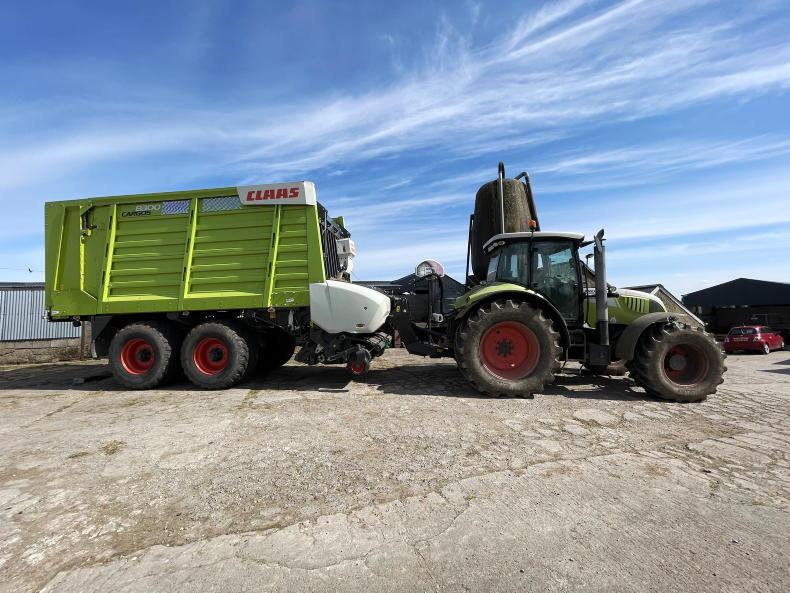




 This is a subscriber-only article
This is a subscriber-only article











SHARING OPTIONS: